True/False
Indicate whether the
statement is true or false.
|
|
|
1.
|
During WWII, the War Production
Board oversaw the conversion from peacetime to a wartime economy
|
|
|
2.
|
George Patton led the U.S.
Third Army in liberating Paris from German occupation
|
|
|
3.
|
Chester Nimitz led U.S. forces
into battle on the island of Bataan, Leyte, Guadacanal and Okinawaw
|
|
|
4.
|
Germany nearly won the Battle
of the Atlantic because the Allies didn't believe their own intelligence
reports.
|
|
|
5.
|
May 8, 1945 or V-E Day, was
celebrated to mark the liberation of the death camps.
|
|
|
6.
|
At the Yalta Conference,
Churchill, Stalin and Roosevelt agreed to move ahead in creating the United
Nations
|
|
|
7.
|
The final decision to use the
atomic bomb against Japan was made by J. Robert Oppenheimer.
|
|
|
8.
|
Atomic bombs were dropped on
the Japanese cities of Nagasaki and Tokyo.
|
|
|
9.
|
James Farmer founded the
interracial movement called the Japanese American Citizens Leagur
|
|
|
10.
|
The Selective service System
was intended to ease servicement back into civilian life by providing free education and guaranteeing
mortgages and business loans
|
Multiple Choice
Identify the
choice that best completes the statement or answers the question.
|
|
|
Americans Join the War
Effort
The Japanese had
attacked Pearl Harbor with the expectation that once Americans had experienced Japan's power,
they would shrink from further conflict. The day after the raid, the Japan Times boasted that the
United States, now reduced to a third-rate power, was "trembling in her shoes." But if
Americans were trembling, it was with rage, not fear. Uniting under the battle cry "Remember
Pearl Harbor," they set out to prove Japan wrong.
| SELECTIVE SERVICE AND THE
GI
After Pearl Harbor,
eager young Americans jammed the recruiting offices. Even the 5 million who volunteered for military
service, however, were not enough to face the challenge of an all-out war on two global fronts-Europe
and the Pacific. The Selective Service System expanded the draft and eventually pro vided another 10
million soldiers to meet the armed forces' needs.
The volunteers and draftees reported
to military bases around the country for eight weeks of basic training . In this short period,
seasoned sergeants did their best to turn raw recruits into disciplined, battle ready GIs . (The
initials GI-meaning "Government Issue"-were first applied to government-issued uniforms,
weapons, and supplies but soon it was used to describe soldiers as well.) According to Sergeant Deb
Myers, however, there was more to basic training than teaching a recruit how to stand at attention,
march in step, handle a rifle, and follow orders. | | |
|
|
|
11.
|
How did American young people
respond to the Japanese attack on Pearl Harbor?
a. | Most looked for ways to avoid the
draft | c. | The youth reacted with anger and
thousands tried to enlist in the armed forces | b. | There was a rush of students trying to get college
deferments | d. | There was a lack of interest amoung
young people. |
|
|
|
12.
|
Which statement is
true?
a. | Enough people enlisted in the armed
forces that the draft was unnecessary | c. | Though millions enlisted the government needed more so it instituted the
draft | b. | Few people enlisted so the government started to draft
people | d. | The government stayed away from the draft so as not to
anger the young people |
|
|
|
13.
|
What does the acronym, GI
mean?
a. | girl
interest | c. | government
idiot | b. | greatly inferior | d. | government issue |
|
|
|
| WOMEN IN THE MILITARY
The military's manpower needs were so great that
early in 1942 Army Chief of Staff General George Marshall pushed for the formation of a Women's
Auxiliary Army Corps (WAAC). "There are innumerable duties now being performed by soldiers that
can actually be done better by women," Marshall said in support of a bill to establish the WAAC
. Under this bill, women volunteering for the army would not receive the same rank, pay, or benefits
as men doing the same jobs, nor could they expect to make the army a career.The bill establishing the
WRAC became law on May 15, 1942 . In all, some 250,000 women served in this and other auxiliary
branches during the war.
| | |
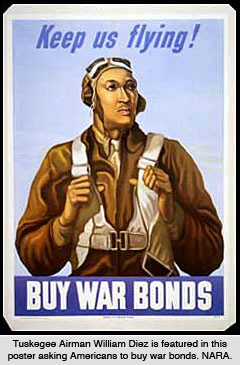
Tuskegee Airman in WWII | MINORITIES IN THE ARMED SERVICES
"We know that under Nazism we should have no
rights at all ; we should be used as slaves," declared a Native American. The Congreso del
Pueblo de Habla Espanola (Spanish Speaking Congress) agreed, proclaiming that "our liberties,
our homes, and our lives [are] directly threatened by Fascism. . . . We are also children
of the United States . We will defend her." In response, at least a half million Mexican
Americans joined the armed forces . All-Latino units saw heavy action both in Europe and in Asia.
While Mexican Americans in Los Angeles made up only a tenth of the city's population, they
suffered a fifth of the city's wartime casualties More than a million African Americans also
served in the military. Black soldiers lived and worked in segregated units and were mostly limited
to non combat roles .
Some 25,000 Native Americans enlisted in the armed services too,
including 800 women. Their willingness to serve led The Saturday Evening Post to comment, "We
would not need the Selective Service if all volunteered like Indians ." For many Native
Americans, the war provided their first opportunity to leave the reservation and meet non-Indians . A
Chippewa wrote a poem describing his experience fighting with soldiers from very different
backgrounds : "We bind each other's wounds and eat the same ration . / We dream of our
loved ones in the same nation." | | |
|
|
|
14.
|
Which statement is
true?
a. | General Marshall was in favor of
enlisting women and had confidence in them | c. | General Marshall was opposed to enlisting women in the
army | b. | General Marshall did not trust women but felt the services needed
them | d. | General Marshall was in favor of women fighting in combat
with men |
|
|
|
15.
|
Which statement is
true?
a. | Most minorities avoided military
service because they were afraid of the war | c. | Most minorities saw the war as a “white man’s fight” and
refused to support the war | b. | Minorities were patriotic and supported the war
effort | d. | Minorities ignored the war and were more interested in
their own problems |
|
|
|
THE INDUSTRIAL RESPONSE

Within weeks of
the shutdown in production, the nation's automobile plants had been retooled to produce tanks,
planes, boats, and command cars. They were not alone: Across the nation, factories were quickly
converted to war production. A maker of mechanical pencils turned out bomb parts . A bedspread
manufacturer made mosquito netting . A soft-drink company converted from filling bottles with liquid
to filling shells with explosives.
Meanwhile, shipyards and defense plants expanded
with dizzying speed. By the end of 1942, industrialist Henry J. Kaiser had built seven massive new
shipyards that turned out Liberty ships (cargo carriers), tankers, troop transports, and
"baby" aircraft carriers at an astonishing rate. Late that year, Kaiser invited reporters
to Way One in his Richmond, California, shipyard to watch as his workers assembled Hull 440, a
Liberty ship, in a record-breaking four days . Writer Alyce Mano Kramer described the first day and
night of construction
Three days later, 25,000 amazed spectators watched as Hull 440 slid into
the water. How could such a ship be built so fast? Kaiser used prefabricated, or factory-made, parts
that could be quickly assembled at his shipyards . Equally important were his workers, who had
learned new skills and performed jobs at record speeds
|
|
|
16.
|
How was Henry Kaiser able to
produce ships so fast?
a. | He employed millions of women
workers | c. | He used cheap
materials | b. | He had the parts prefabricated and later put together in
sections | d. | He used the automobile factories to
build ships |
|
|
|
17.
|
Which statement is
true?
a. | Within a year American industry had
converted over to war production | c. | American industry only cared about making
money | b. | It only took industry three years to convert over to war
production | d. | American industry resisted the
conversion to war production |
|
|
|
18.
|
Henry Kaiser is most famous
for
a. | food processing
plants | c. | military housing
units | b. | ship yards | d. | aircraft factories |
|
|
|
 | LABOR'S CONTRIBUTION
When the war began, defense contractors warned the
Selective Service System that the nation did not have enough manpower to meet both its military and
its industrial needs . They were wrong. By 1944, despite the draft, nearly 18 million workers were
laboring in war industries, three times as many as in 1941.
More than 6 million of these new
workers were women. At first, war industries feared that most women lacked the necessary stamina for
factory work and were reluctant to hire them . But once women proved they could wield welding torches
or riveting guns as well as men, employers could not hire enough of them-especially since women
earned only about 60 percent as much as men doing the same jobs . | Defense plants also hired more than 2 million minority workers during the war
years.To protest discrimination both in the military and in industry, A. Philip Randolph, president
of the Brotherhood of Sleeping Car Porters and the nation's leading African-American labor
leader, organized a march on Washington . Randolph called on blacks everywhere to come to the capital
on July 1, 1941, and to march under the banner "We Loyal Colored Americans Demand the Right to
Work and Fight for Our Country."
The president issued an executive order calling on
employers and labor unions "to provide for the full and equitable participation of all workers
in defense industries, without discrimination because of race, creed, color, or national origin
." | | |
|
|
|
19.
|
What civil rights leader tried
to pressure the U.S. Government to integrate the defense industry?
a. | Martin Luther
King | c. | John L.
Lewis | b. | Phillip Randolph | d. | W.E.B. Dubois |
|
|
|
20.
|
Why was industry eager to hire
women and minorities in the defense industry?
a. | they were better workers
| c. | a large part of the man power was in
the military services | b. | they made less money | d. | women were in charge of many of the defense
plants |
|
|
|
MOBILIZATION OF
SCIENTISTS
That same year,
Roosevelt created the Office of Scientific Research and Development (OSRD) to bring scientists into
the war effort. The OSRD spurred improvements in both radar and sonar, a new technology for locating
submarines underwater. It encouraged the use of pesticides like DDT to fight insects . As a result,
U.S . soldiers were probably the first in history to be relatively free from body lice. The OSRD also
pushed the development of "miracle drugs," such as penicillin, that saved countless lives
on and off the battlefield
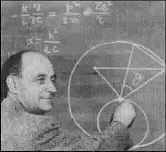 
The greatest scientific
achievement of the OSRD, though, was the secret development of a new weapon, the atomic bomb.
Interest in such a weapon began in 1939, after German scientists succeeded in splitting uranium
atoms, releasing an enormous amount of energy. This news prompted physicist and German refugee Albert
Einstein to write a letter to President Roosevelt, warning that the Germans could use their discovery
to construct a weapon of enormous destructive power.
Roosevelt responded by creating a
National Committee on Uranium to study the new discovery. In 1941, the committee reported that it
would take from three to five years to build an atomic bomb. Hoping to shorten that time, the OSRD
set up a crash program in 1942 to develop a bomb as quickly as possible . Because its offices were
located in New York City, the atomic bomb program came to be known as the Manhattan
Project
|
|
|
21.
|
Who convinced President
Roosevelt to invest in the creation of an atomic bomb?
a. | Sigmund
Freud | c. | A Phillip
Randolph | b. | Henry Kaiser | d. | Albert Einstein |
|
|
|
22.
|
except for the atomic bomb,
World War Two is responsible for very few advances in science. .
|
|
|
CHANGES IN ENTERTAINMENT
The war not only put Americans back to work but also put
money in their pockets . As a result, spending on entertainment more than doubled between 1941 and
1945.
From 60 million to 100 million Americans (out of a total population of 135 million) went
to the movies each week. In the aftermath of Pearl Harbor, Hollywood churned out war-oriented
propaganda films. Heroic movies like Mission to Moscow and Song of Russia glorified America's
new wartime ally, the Soviet Union. "Hiss-and-boo" films with titles like Hitler, Beast of
Berlin stirred up hatred against the enemy. As the war dragged on, however, people grew tired of
propaganda and war themes. Hollywood responded with musicals, romances, comedies, and other escapist
fare designed to take filmgoers away from the grim realities of war, if only for an hour or
two.
 | 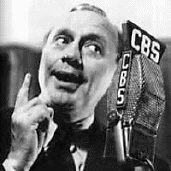
The Jack Benny Radio Show

Fanny
Brice |
 | | | |
Meanwhile, public hunger for war news spurred a boom in
the publishing and radio industries. Magazines such as Life, Look, and Time, which covered the war in
both words and pictures, saw their cir culation soar. Radio audiences also reached record levels as
people tuned in the latest war reports . Between newscasts, listeners could follow the radio soap
operas' tales of love gone wrong, or they could escape wartime concerns by laughing at comedians
such as Jack Benny and Fanny Brice .
|
|
|
23.
|
Hollywood went out of its way
to glorify the Communist Soviet Union in World War Two
|
|
|
24.
|
During World War Two the war
dominated
a. | movies | c. | magazines | b. | radio | d. | all of these |
|
|
|
25.
|
In WWII Americans
a. | had less money to spend on
entertainment because of the war | c. | did not go to the movies much | b. | had more money to spend on
entertainment | d. | did not listen to the radio
much |
|
|
|
26.
|
Which statement is true about
WWII entertainment?
a. | the entertainment industry tried to
show the Axis side as well as the Allied side of World War II issues | c. | the entertainment industry acted as a propaganda machine
for the Allies | b. | the entertainment industry acted as a propaganda machine for the
Axis | d. | none of these are
true |
|
|
|
INTERNMENT OF JAPANESE AMERICANS
After the bombing of Pearl
Harbor, many Americans questioned the loyalty of Japanese Americans living in Hawaii and on the West
Coast. They feared that these Asian Americans were part of Japan's master plan for destroying
the United States. Early in 1942, the War Department called for the mass evacuation of all Japanese
Americans from Hawaii. General Delos Emmons, the military governor of Hawaii, resisted the order
because 37% of the people in Hawaii were Japanese Americans. To remove them would have destroyed the
islands' economy and hindered U.S. military operations there. However, he was eventually forced
to order the internment, or confinement, of 1,444 Japanese Americans, 1 percent of Hawaii's
Japanese-American population.
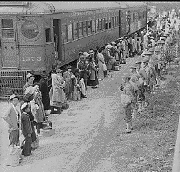 | | 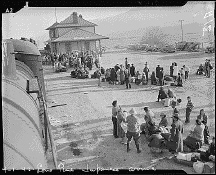 | | | |
On the West Coast, however, panic and prejudice ruled the day. In
California, only 1 percent of the people were Japanese. Newspapers whipped up anti- Japanese
sentiment by running ugly stories attacking Japanese Americans daily On February 19, 1942,
President Roosevelt signed an order requiring the removal of people of Japanese ancestry from
California and parts of Washington, Oregon, and Arizona. He justified this step as necessary for
national security. In the following weeks, the army rounded up some 110,000 Japanese Americans and
shipped them to ten hastily constructed internment camps . About two-thirds were Nisei, or Japanese
Americans who had been born in this country and were thus American citizens . Thousands of Nisei had
already been drafted into the armed forces.
|
|
|
27.
|
The government had no right to
inter the west coast Japanese because they were all American citizens.
|
|
|
28.
|
According to the U.S.
Government, American communists were to the Soviet Union as west coast Japanese were to
a. | the United
States | c. | Asia | b. | Japan | d. | Europe |
|
|
|
29.
|
The Nisei
were
a. | citizens of
Japan | c. | loyal to the Emperor of
Japan | b. | citizens of the U.S. and Japan | d. | citizens of the U.S. |
|
|
|
ECONOMIC
CONTROLS
Another problem for the federal government was
preventing inflation from skyrocketing, as it had during World War I . With incomes rising and the
production of consumer goods falling, prices were bound to soar.
Congress responded to this
threat by passing legislation to create the Office of Price Administration (OPA) . The OPA fought inflation by freezing
prices on most goods. Congress also raised income-tax rates and extended the tax to millions of
people who had never paid it before. The higher taxes reduced consumer demand on scarce goods by
leaving workers with less to spend. In addition, the government encouraged Americans to use their
extra cash to buy war bonds. As a result of these measures, inflation remained below 30 percent-about
half that of World War 1-for the entire period of World War 11.
Besides controlling
inflation, the government needed to ensure that the armed forces and war industries received the
resources they needed to win the war. The War Production Board (WPB) assumed that
responsibility. The WPB decided which companies would convert from peacetime to wartime production
and allocated raw materials to key industries. The WPB also organized nationwide drives to collect
scrap iron, tin cans, paper, rags, and cooking fat for recycling into war goods . Across America,
children scoured attics, cellars, garages, vacant lots, and back alleys, looking for useful junk.
During one five-month-long paper drive in Chicago, schoolchildren collected 36 million pounds of old
paper-about 65 pounds per child.
In addition, the OPA set up a system for rationing, or
establishing fixed allotments of goods deemed essential for the military. Under this system,
households received ration books with coupons to be used for buying such scarce goods as meat, shoes,
sugar, coffee, and gasoline . Gas rationing was particularly hard on those who lived in Western
regions, where driving was the only way to get around. Eleanor Roosevelt sympathized with their
complaints . "To tell the people in the West not to use their cars," she observed,
"means that these people may never see another soul for weeks and weeks nor have a way of
getting a sick person to a doctor."
Most Americans accepted rationing as a personal
contribution to the war effort . Workers car-pooled or rode bicycles. Families coped with shortages
of everything from tires to toys. Inevitably, some cheated by hoarding scarce goods or by purchasing
them through the "black market," where rationed items could be bought illegally without
coupons at inflated prices .
In 1943, the WPB hired Harvard professor Thomas North Whitehead
to tour the nation and find out how Americans were reacting to rationing and controls. He reported
that "the good temper and common sense of most people under restrictions and vexations was
really impressive . . . . My own observation is that most people are behaving like patriotic, loyal
citizens
While people tightened their belts at home, millions of other Americans put their
lives on the line for their country in air, sea, and land battles on the other side of the
world.
|
|
|
30.
|
What is
inflation?
a. | Falling
prices | c. | Rising
wages | b. | Rising prices | d. | Falling wages |
|
|
|
31.
|
In World War Two the government
raised taxes. What effect did this have on the economy.
a. | Helped prices to remain
stable | c. | Caused a short
depression | b. | Caused prices to rise | d. | Helped the people to buy more war
bonds. |
|
|
|
32.
|
How did the Office of Price
Administration maintain the supply of food and gasoline.
a. | raising
prices | c. | paying farmers and oil companies
more money | b. | rationing | d. | cutting supplies to the military |
|
|
|
33.
|
What agency was responsible for
getting scrap metal, rubber and other materials to the defense industry.
a. | Office of Price
Administration | c. | War Production
Board | b. | Office of Strategic Supplies | d. | Works Progress Administration |
|
|
|
34.
|
How did most Americans respond
to government economic policies during World War Two?
a. | They fought against policies that
would hurt them financially | c. | They called for marches and demonstrations, putting their own issues before
the nations. | b. | They ignored government policies that caused personal financial
hardship | d. | They supported the policies because
it made them feel they were doing their part to win the
war. |
|
|
|
The United States and
Britain Join Forces
WAR
PLANS
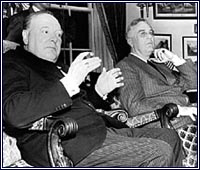 Churchill & Roosevelt at White House Churchill & Roosevelt at White House | After the attack on Pearl Harbor and
America’s entry into the war, Prime Minister Churchill arrived at the White House on
December 22, 1941, and spent the next three weeks working out war plans with President Roosevelt.
Their first major decision was to make the defeat of Germany the Allies top priority. There were
several reasons for this policy
· Roosevelt had always considered Adolf Hitler the number
one enemy of the United States .
· " Joseph Stalin, whose Soviet Union was now one of
the Allies, was desperate for help against invading German forces .
· " Only after
Germany was defeated could the United States look to Britain and the Soviet Union for help in
defeating Japan |
A second important decision the two
leaders made was to accept only the unconditional surrender of the Axis powers . An unconditional
surrender meant that Germany and Japan had to accept any conditions imposed by the allies. Some
historians have criticized this decision, arguing that it led Germany and Japan to fight longer and
more desperately than they might otherwise have done. The Allied leaders, however, were united in
their belief that "complete victory . . . [was] essential to defend life, liberty, and
religious freedom, and to preserve human rights and justice in their own lands as well as in other
lands."
By the end of their meeting, Roosevelt and Churchill had formed, in
Churchill's words, "a very strong affection, which grew with our years of comradeship
. | | |
.
|
|
|
35.
|
Who was the leader of Great
Britain in WW2, who was also a friend of FDR?
a. | Winston
Churchill | c. | Neville
Chamberlain | b. | Joseph Stalin | d. | Charles DeGaulle |
|
|
|
36.
|
FDR and Churchill decided to go
after Germany first. Which was not a reason for defeating Germany first?
a. | The Soviet Union was
Communist | c. | FDR thought Hitler
was a bigger threat than Japan | b. | England and the Soviets might not help the U.S. until Germany was
defeated | d. | The Soviets needed help in defeating
the Germans |
|
|
|
37.
|
Some people thought that
demanding an unconditional surrender from Germany was a mistake. Why might it be a
mistake.
a. | Germany and Japan might not remain
allies under an unconditional surrender plan | c. | The Axis might think they had nothing to loose by continuing to fight. This
may have made the war last longer. | b. | The Germans might give up their persecution of the Jews in
Europe | d. | Germany might get more favorable conditions in an
unconditional peace treaty. |
|
|
|
THE BATTLE OF THE
ATLANTIC
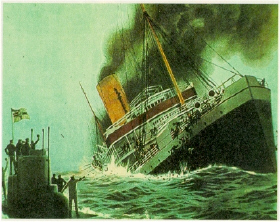 German UBoats sink Allied ships German UBoats sink Allied ships | 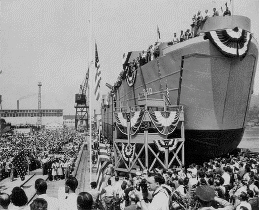
American ship
building in WWII
The U.S. built ships faster than the Germans could sink
them | | |
After the attack
on Pearl Harbor, Hitler ordered submarine raids against ships along America's East Coast.
Unprotected American ships proved to be easy targets . In the first four months of 1942, the Germans
sank 87 U.S. ships off the Atlantic shore . Seven months into the year, German wolf packs had
destroyed a total of 681 Allied ships in the Atlantic. Something had to be done or the war would be
lost at sea
The Allies responded by organizing their cargo ships into convoys, or groups for
mutual protection, as they had done in the First World War. The convoys were escorted across the
Atlantic by destroyers equipped with sonar for detecting submarines underwater and by airplanes that
used radar to spot Uboats on the ocean's surface . With this improved tracking, the Allies were
able to find and destroy German U-boats faster than the Germans could build them. In May 1943,
Admiral Karl Doenitz, the commander of the German U-boat offensive, reported that his losses had
"reached an unbearable height."
At the same time, the United States launched a crash
shipbuilding program. Between 1939 and 1940, the United States had built only 102 ships. By early
1943, though, 140 Liberty ships alone were being produced each month . For the first time in the war,
launchings of Allied cargo ships began to outnumber sinkings.
By mid-1943, the tide of the
Battle of the Atlantic had turned in the Allies favor. A happy Churchill reported to the House of
Commons that June "was the best month [at sea] from every point of view we have known
in the whole 46 months of the war."
|
|
|
38.
|
What was the greatest threat to
the U.S. and Great Britain in the Atlantic in 1941 and 1942
a. | Japanese aircraft
carriers | c. | German U
Boats | b. | Advanced German weapons like buzz bombs and
missiles. | d. | German air
raids |
|
|
|
39.
|
Why was the war in the Atlantic
ocean important?
a. | American ships were supplying the
allies with important war materials | c. | America needed to keep the trade routes open | b. | Germany was threatening to invade the continental United
States | d. | War was bad for business to the countries of
Europe |
|
|
|
40.
|
How did the Allies respond to
the German threat in the Atlantic
a. | increased satellite surveillance of
the ships crossing the Atlantic | c. | started shipping from South America to Europe
| b. | organized the ships into convoys and
protected them with escort ships | d. | increased our carrier fleet in the
Atlantic |
|
|
|
The Eastern Front and the
Mediterranean
By the summer
of 1943, the Allies began to see victories on land as well. The first great turning point came in the
Battle of Stalingrad.
THE
BATTLE OF STALINGRAD
The initial German push into the Soviet Union had stalled in front of Moscow
and Leningrad (now St. Petersburg) in early 1942. With the German war machine running low on oil, Hitler
changed his tactics. He sent his Sixth Army south with two objectives: (1) to seize the rich Soviet
oil fields in the Caucasus Mountains, and (2) to capture Stalingrad (now Volgograd), a major
industrial center on the Volga River. Once the Germans controlled Stalingrad, they could cut the
movement of military supplies along the Volga River to Moscow.
For three months the Germans
pressed in on Stalingrad, conquering it house by house in brutal hand-to-hand combat. By the end of
September, they controlled nine-tenths of the city-or what was left of it.
In November, the
Soviets launched a massive counterattack. Hitler's military advisers begged him to order a
retreat before the Sixth Army was trapped. The Fuehrer, every bit as stubborn as Stalin, refused,
shouting, "I won't go back from the Volga." The Germans were ordered to stand and
fight to the last man
The fighting continued as winter turned Stalingrad into a frozen
wasteland. "We just lay in our holes and froze, knowing that 24 hours and 48 hours later we
should be shivering precisely as we were now," wrote a German soldier, Benno Zieser. "But
there was now no hope whatsoever of relief, and that was the worst thing of all." On February 2,
1943, Zieser and some 91,000 other frost-bitten, lice-ridden, half-starved German troops surrendered.
They were all that was left of the army of 330,000 that had come to Stalingrad what seemed like a
lifetime ago
In defending Stalingrad, the Soviets lost a total of 1,250,000 soldiers and
civilians- more than all American casualties during the entire war. Despite the staggering death
toll, the Soviets' victory on the Volga marked a turning point in the war in the east. From
that point on, the Soviet army began to move steadily westward toward
Germany.
|
|
|
41.
|
Why was the Battle of
Stalingrad important to the war in Europe
a. | It allowed communism to take root in
the Soviet Union | c. | The Americans and
Russians could not join forces on the Eastern front in Europe | b. | It was a massive defeat for the German army and consumed
huge German resources and manpower. | d. | It was a huge lose for the Soviet
Union |
|
|
|
42.
|
Why was Germany defeated at
Stalingrad?
a. | German supply lines were stretched
too thin | c. | Hitler’s
refusal to take the advice of his generals | b. | The bitter cold Russian
winter | d. | all of these |
|
|
|
THE NORTH AFRICAN FRONT
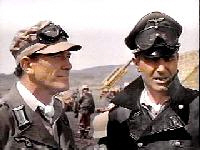
General Erwin Rommel | 
General George Patton | | |
While the battle of Stalingrad raged, Stalin pressured Britain and America
to open a "second front" in western Europe. He argued that an invasion across the English
Channel would force Hitler to divert troops from the Soviet front. Churchill and Roosevelt
didn't think the Allies had enough troops. Instead, they launched Operation Torch, an invasion
of Axis-controlled North Africa, commanded by American general Dwight D . Eisenhower.
In
November 1942, some 107,000 Allied troops, the great majority of them Americans, landed in
Casablanca, Oran, and Algiers in North Africa. Soon after General George Patton took leadership of
the American forces. Pattons troops and tanks sped eastward, chasing the Afrika Korps led by General
Erwin Rommel, the legendary Desert Fox. After months of heavy fighting, the last of the Afrika Korps
surrendered in May 1943. British general Harold Alexander sent a message to Churchill, reporting that
"All enemy resistance has ceased. We are masters of the North African shores
."
|
|
|
43.
|
Who was the leader of American
forces in North Africa that defeated the Germans?
a. | Erwin
Rommel | c. | General
Alexander | b. | George Patton | d. | General Marshall |
|
|
|
44.
|
Who was the great German
General in North Africa known as the Dessert Fox? He was Hitters favorite general but later became
involved in a plot to kill Hitler.
a. | George Von
Patton | c. | General
Montgomery | b. | Erwin Rommel | d. | General Franz Eisenhower |
|
|
|
THE ITALIAN
CAMPAIGN
Even before the battle in North Africa was won, Roosevelt, Churchill, and
their commanders met in Casablanca to decide where to strike next. The Americans argued that the best
approach to victory was to assemble a massive invasion fleet in Britain and to launch it across the
English Channel, through France, and into _ the heart of Germany. Churchill, however, thought it
would be safer to first attack Italy, "the soft underbelly of the Axis." The Allies
compromised. They would push ahead with plans for the cross-channel invasion ; meanwhile, Allied
troops would invade Italy.
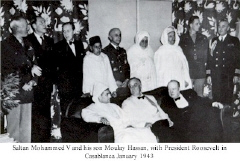
Roosevelt and
Chruchill at Casablanca | 
Mussolini and
Mistriss hung | | |
The Italian campaign got off to a good start with the capture of Sicily in
the summer of 1943 . By then, the Italians were weary of war. On July 25, 1943, King Victor Emmanuel
III summoned the Fascist dictator and prime minister Benito Mussolini to his palace and stripped him
of power. "At this moment," the king told Il Duce, "you are the most hated man in
Italy." As he left the palace, Mussolini was arrested, and Italians began celebrating the end of
the war.
But their cheers were premature. Hitler responded by seizing control of Italy,
reinstalling Mussolini as its leader, and ordering German troops to dig in and hold firm. It took 18
months of miserable fighting in the mud and mountains for the Allies to drive the Germans from
Italian soil. One of the hardest battles the Allies encountered in Europe was fought less than 40
miles from Rome . This battle, "Bloody Anzio," lasted four months-until the end of May
1944-and left about 25,000 Allied and 30,000 Axis soldiers dead.
On April 28, 1945, partisans
who had ambushed a Nazi convoy found Mussolini disguised as a German soldier in one of the trucks .
The next day, they shot Il Duce and hung his body in a Milan square. At the time of his arrest in
1943, Mussolini had prophetically described his own fate : "From dust to power and from power
back to dust." The Allies Liberate Europe
As Allied troops pushed northward through
Italy, the Soviet army moved westward into Poland. Meanwhile, in England, General Eisenhower
organized -- - Operation Overlord, the planned invasion of Hitler's "fortress Europe
."
|
|
|
45.
|
After the defeat of Germany in
North Africa, where did Churchill and Roosevelt meet to decide where to attack Germany
next.
a. | Casablanca | c. | London | b. | Algiers | d. | Sicily |
|
|
|
46.
|
Who was the Fascist Axis leader
of Italy in World War II?
a. | King
Emmanuel | c. | Erwin
Rommel | b. | Juan Peron | d. | Benito Mussolini |
|
|
|
47.
|
Where did the Allies begin
their attack on the Axis in Italy
a. | Normandy | c. | Palermo | b. | Sicily | d. | Greece |
|
|
|
48.
|
At Casablanca the Allies had to
decide how to attack Germany next. What two places did they have to choose from?
a. | Normandy or
France | c. | Italy or
France | b. | England or Italy | d. | Stalingrad or France |
|
|
|
D-DAY
For two years the
United States and Britain had been building an invasion force of ships, landing craft, and nearly 3
million troops to attack Axis forces on the other side of the English Channel. Eisenhower hoped to take the Axis by surprise and
pinpointed the relatively lightly fortified Normandy peninsula as the focus of the assault. To make
reinforcement of the German forces more difficult once the invasion began, the Allies bombed northern
France's supply routes-roads, bridges, and rail lines-for a month and a half before the planned
assault.
D-Day, the day of the invasion, had originally been set for June 5, but had
weather forced a delay. Banking on a forecast for clearing skies, Eisenhower gave the go-ahead for
the next day-and June 6, 1944, became a day that will live in history.
Three divisions
parachuted down behind German lines during the night, and British, American, and Canadian troops
fought their way ashore at five points along the 60-mile stretch of beach . With 156,000 troops,
4,000 landing craft, 600 warships, and 11,000 planes, it was the largest land-sea-air operation in
history. Despite the massive air and sea bombardment by the Allies before the invasion, German
retaliation was brutal, particularly at Omaha Beach. "People were yelling, screaming, dying,
running on the beach, equipment was flying everywhere, men were bleeding to death, crawling, lying
everywhere, firing coming from all directions," soldier Felix Branham wrote of the scene there .
"We dropped down behind anything that was the size of a golf ball."

Gen Dwight Eisenhower | 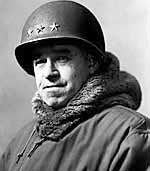
General Omar
Bradley | 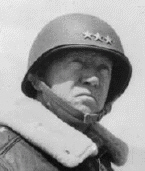
Gen George Patton | | | |
Despite heavy
casualties, the Allies held the beachheads. Within a month, they had landed a million troops, 567,000
tons of supplies, and 170,000 vehicles in France . On July 25, General Omar Bradley unleashed massive air and land
bombardment against the enemy giving General George Patton and his Third army the gap they needed to
advance. On August 23, they reached the Seine River south of Paris . Two days later, French
resistance troops and American troops liberated the French capital from four years of German
occupation. Patton announced this joyous event to his commander in a message that read, "Dear
Ike: Today I spat in the Seine."
By September 1944, the Allies had freed France, Belgium,
Luxembourg, and much of the Netherlands. This good news-and the American people's desire not to
"change horses in midstream"-helped elect Roosevelt to an unprecedented fourth term in
November, along with his new moderate running mate, Senator Harry S . Truman.
|
|
|
49.
|
What was D
day?
a. | The German invasion of
Dunkirk | c. | The Allied
invasion of France | b. | The Allied invasion of Denmark | d. | The Allied invasion of Germany |
|
|
|
50.
|
What body of water did the
Allies have to cross in the D Day invasion?
a. | English
Channel | c. | North
Sea | b. | Atlantic Ocean | d. | Normandy Sea |
|
|
|
51.
|
The D Day invasion forced the
Germans to divert forces the war in _____
a. | the
Atlantic | c. | North
Africa | b. | Russia | d. | Italy |
|
|
|
THE BATTLE OF THE
BULGE
In October 1944, Americans captured their first German
town, Aachen. Hitler responded with a surprising counterattack . He ordered his troops to break
through the Allied lines and to recapture the Belgian port of Antwerp. This bold move, the Fuehrer
hoped, would disrupt the enemy's supply lines and demoralize the Allies. Also, Hitler was
devloping new weapons, such as the atomic bomb, jet planes and rockets. He thought this battle would
hold back the allies long enough for him to finish developing his new weapons.
On December
16, under cover of dense fog, eight German tank divisions broke through weak American defenses along
an 80-mile front. The resulting dent in the Allied lines gave this desperate last ditch offensive its
name, the Battle of the Bulge.
As the Germans swept westward, they captured 120 American GIs near Malmedy. Elite German troops-the
SS troopers-herded the prisoners into a field and mowed them down with machine guns and pistols .
Private Homer Ford was one of the 43 who somehow survived.
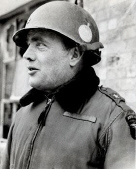
General Anthony McAuliffe |
American troops led by Brigadier General Anthony McAuliffe made a heroic stand at
the Belgian town of Bastogne. Surrounded and badly outnumbered, McAuliffe received a surrender
demand from the Germans . His reply was just one word:..............
"Nuts!"
| | |
The initial success of the German offensive was due mainly to their
ability to keep the Allies off guard. The battle raged for a month. When it was over, the Germans had
been pushed back and little seemed to have changed . But, in fact, things had taken a decisive turn.
The Germans had lost 120,000 troops, 600 tanks and assault guns, and 1,600 planes in the Battle of
the Bulge-men and weapons they could not replace . Also, the Germans ran out of fuel and could not
continue the battle. From that point on, the Nazis could do little but retreat .
|
|
|
52.
|
What was the Battle of the
Bulge?
a. | Hitlers counterattack against the
allies | c. | Germany’s last serious attack
on the allies | b. | A surprise attack by the German Army | d. | all of these |
|
|
|
53.
|
Where did the German attack in
the Battle of the Bulge stall
a. | the town of Bastogne | c. | the town of
Malmedy | b. | Paris | d. | it did not stall, it was a German
success |
|
|
|
54.
|
What did General Anthony McAuliffe say to the Germans when they offered him
surrender?
a. | “never” | c. | “you first” | b. | “make your offer to
headquarters” | d. | “nuts” |
|
|
|
LIBERATION OF THE DEATH
CAMPS
Meanwhile, Allied troops pressed eastward into the German heartland, and
the Soviet army pushed westward across Poland toward Berlin . Soviet troops were the first to come
upon one of the Nazi death camps, in July 1944. As the Soviets drew near a camp called Majdanek in
Poland, SS guards worked feverishly to bury and burn all evidence of their crimes . But they ran out
of time. When the Soviets entered Majdanek, they found a thousand "living corpses," the
world's largest crematorium, and a storehouse containing 800,000 shoes. "This is not a
concentration camp," reported a stunned Soviet war correspondent, "it is a gigantic murder
plant." The Americans who later liberated death camps in Germany were equally
overwhelmed.
|
|
|
55.
|
What did the SS do as the
Allied armies advanced toward Germany and over-ran the death camps.
a. | they tried to cover-up what they had
done | c. | they tried to make friends with the
Jewish inmates | b. | they tried to surrender to the Russians | d. | they did nothing |
|
|
|
UNCONDITIONAL SURRENDER
By April 25, 1945, the Soviet army had stormed Berlin. As Soviet shells
burst overhead, the city panicked. The Soviet soldiers went on a killing and raping spree.
In
his underground headquarters in Berlin, Hitler prepared for the end. On April 29, he
married Eva Braun, his longtime
companion . The same day, he wrote out his last address to the German people. In it he blamed the
Jews for starting the war and his generals for losing it. "I myself and my wife choose to die in
order to escape the disgrace of . . . capitulation [surrender]," he said. "I die
with a happy heart aware of the immeasurable deeds of our soldiers at the front." The next day
Hitler shot himself while his new wife swallowed poison.
In accordance with Hitler's
orders, the two bodies were carried outside, soaked with gasoline, and burned. A week later, General
Eisenhower accepted the unconditional surrender of the Third Reich. On May 8, 1945, the Allies
celebrated V-E Day-Victory in Europe Day. The first part of the war was finally
over.
|
|
|
56.
|
What was the end of the war in
Europe called?
a. | VE Day | c. | Allied Victory Day - V
day | b. | Armistice Day | d. | Victory over Germany Day - VD
day |
|
|
|
57.
|
On what date did the War in
Europe end?
a. | April 2,
1945 | c. | April 29,
1945 | b. | April 8, 1945 | d. | May 8, 1945 |
|
|
|
The Allies Stem the Japanese
Tide
While the Allies
agreed that the defeat of the Nazis was their first priority, the United States did not wait until
V-E Day to move against Japan. Fortunately, the Japanese attack on Pearl Harbor in 1941 had missed
the Pacific Fleet's submarines . Even more importantly, the attack had missed the fleet's
aircraft carriers, which were at sea at the time. In addition, almost all of the sunk or damaged
ships were repaired and returned to service
JAPANESE ADVANCES
In the first six
months after Pearl Harbor, the Japanese conquered an empire that dwarfed Hitler's Third Reich.
On the Asian mainland, Japanese troops overran Hong Kong, French Indochina, Malaya, Burma, Thailand, and half of China. They
also swept south and east across the Pacific, conquering Formosa, the Dutch East Indies, Guam,
Wake Island, the Solomon Islands, and countless other dots in the ocean, including two islands in the
Aleutian chain, which were part of Alaska
In the Philippines, 80,000 American and Filipino troops
commanded by General Douglas
MacArthur held out against 200,000 invading Japanese troops for four months on the Bataan
Peninsula and for another month on the island of Corregidor at the entrance to Manila Bay. Hunger,
disease, and bombardments took a terrible toll- 14,000 killed and 48,000 wounded. Finally MacArthur
was ordered to abandon the Philippines. As he left, he pledged to the many thousands of his men who
did not make it out, "I shall return ."
Japan's admirals and generals
were dazzled by their success. Not only had they surpassed the Allies militarily, but they had also
destroyed the myth of white supremacy in Asia.
|
|
|
58.
|
How did the attack on Pearl
Harbor miss the U.S. Carriers?
a. | The Japanese did not think they were
important | c. | The carriers were
in San Diego on December 7 | b. | The carriers were out to sea | d. | They did not miss. Most of the U.S. carriers were
sunk |
|
|
|
59.
|
Who was the American general
who was forced to leave the Philippines but vowed, “I shall return.”
a. | George
Patton | c. | Douglas
MacArthur | b. | Dwight Eisenhower | d. | Doug Wainright |
|
|
|
60.
|
Which statement is
true?
a. | By 1942 Japan controlled most of
Asia and seemed invincible | c. | By 1942 the Japanese army was afraid that it would loose the
war | b. | By 1942 the U.S. was chasing the Japanese army back to
Japan | d. | By 1942 the Japanese were driven out of the
Philippines |
|
|
|
U.S .
RETALIATION
On April 18,
1942, 16 B-25 bombers, led by Colonel James Doolittle, took off from the aircraft carrier Hornet . Hours later
they swept in from the sea over Tokyo and four other Japanese cities, blasting factories, steel
mills, oil tanks, and other military targets before vanishing. The next day America awoke to
headlines proclaiming "Tokyo Bombed! Doolittle Did it" It." Seeing the U.S. pull off a
Pearl Harbor-style air raid over Japan lifted Americans' sunken spirits.
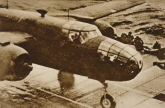 Gen
Doolittle Raid on Tokyo Gen
Doolittle Raid on Tokyo
Early in May, a combined American and Australian fleet intercepted
a Japanese strike force aimed at Australia. This confrontation, the Battle of the Coral Sea,
established a new type of naval warfare.
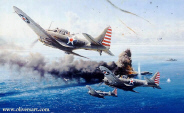
All the fighting was done
by carrier-based airplanes; the opposing ships never saw one another or exchanged gunfire. The
Allies lost more ships than the Japanese, so that the Japanese were able to declare victory. But the
real triumph belonged to the Allies . By the end of the battle, the Japanese fleet was too short
of fuel to continue on to Australia. For the first time since Pearl Harbor, a Japanese invasion
had been stopped and turned back.
THE BATTLE OF MIDWAY
In June, Admiral Chester Nimitz, the commander of American naval forces in the
Pacific, learned from intercepted messages that a Japanese invasion force of well over 110 ships-the
largest assemblage of naval power in history-was heading toward Midway, a strategic island in the
Pacific. From there, the invasion force planned to move on to Hawaii to finish the destruction of
American naval power started at Pearl Harbor.
Even though he was outnumbered four to one in
ships and planes, Nimitz prepared a surprise reception for the Japanese at Midway. As the enemy drew
near, he ordered his carrier planes into the air again and again, with orders "to inflict
maximum damage on the enemy." The results were devastating. By the end of the Battle of Midway,
the Japanese had lost four irreplaceable aircraft carriers, a cruiser, and 322 planes . In the words
of a Japanese official, at Midway the Americans had "avenged Pearl Harbor." It was the
battle that turned the war against Japan.
|
|
|
61.
|
Who lost more ships in the
Battle of the Coral Sea?
a. | Japan | c. | British | b. | America | d. | Germany |
|
|
|
62.
|
What new type of naval warfare
was established at the Battle of Coral Sea?
a. | Naval battles between big
battleships | c. | Submarine
warfare | b. | Fighting with fighter planes from aircraft
carriers | d. | The use of radar and sonar to locate
and sink ships |
|
|
|
63.
|
Why was the battle of Coral sea
significant
a. | Gave control of the Coral Sea to
Japan | c. | Enabled Japan to control
Indonesia | b. | Drove the Japanese out of Southeast Asia | d. | Stopped the Japanese advance toward
Australia |
|
|
|
64.
|
Which statement is true about
the battle of Midway.
a. | Midway enabled the Japanese to
attack Pearl Harbor | c. | Midway proved that
the Japanese navy was more powerful than the American Navy and turned the war in favor of Japan and
the Axis Powers. | b. | Midway was the beginning of the end for Japan in
WWII | d. | Midway was a huge defeat for the Japanese navy and turned
the tide of the war in favor of the United States |
|
|
|
ISLAND
HOPPING
The Pacific war was
one of vast distances. Japanese troops were dug in on hundreds of islands scattered across thousands
of miles of ocean. To storm each one, MacArthur argued, would have been "a long and costly
effort." Instead, he wanted to leapfrog, or bypass, Japanese strongholds. MacArthur seized
less-well-fortified islands, built airfields on them, and then used air power to cut supply lines to
enemy troops in the area. As a result, a Japanese intelligence officer later reported, "Our
strong points were gradually starved out."
The Americans' first land offensive of
the war began in August 1942, when 19,000 marines stormed Guadalcanal in the Solomon Islands. Guadalcanal
marked Japan's first defeat on land, but not its last. The Americans continued leapfrogging
across the Pacific toward Japan, and in October 1944, some 178,000 Allied troops and 738 ships
converged on Leyte Island in the Philippines . General MacArthur, who had left the American colony
two years earlier, waded ashore and announced, "People of the Philippines: I have
returned."
The Japanese threw their entire fleet into the battle for Leyte Gulf. They
also tested a new tactic, the kamikaze, or suicide-plane, attack in which Japanese pilots crashed
their bomb-laden planes into Allied ships. (Kamikaze means "divine wind" and refers to a
legendary typhoon that saved Japan in 1281 by destroying a Mongol invasion.) In the Philippines, 424
kamikaze pilots embarked on suicide missions, sinking 16 ships and damaging another 80.
Despite the damage done by the kamikazes, the Battle of Leyte Gulf was a disaster for Japan.
In three days of battle, it lost 3 battleships, 4 aircraft carriers, 13 cruisers, and almost 400
planes . From then on, the Imperial Navy played only a minor role in the defense of
Japan.
After retaking the Philippines and liberating the American prisoners of war there, the
Allies turned to Iwo Jima, Iwo Jima was critical to the United States as a base from which heavily
loaded bombers could reach Japan. It was also perhaps the most heavily defended spot on earth, with
20,700 Japanese troops entrenched in tunnels and caves. More than 6,000 marines died taking this
desolate island, the greatest number in any battle in the Pacific to that point. Only 200 Japanese
survived . Just one obstacle now stood between the Allies and a final assault on Japan-the island of
Okinawa.
|
|
|
65.
|
The U.S. used a strategy called
“Island Hopping” in the Pacific against Japan. What was this
strategy?
a. | The U.S. invaded only certain
islands, bypassing others | d. | all of these are part of the strategy | b. | The U.S. cut Japans supply lines with air
strikes | e. | none of these were part of the
strategy | c. | The U.S. established air bases on captured islands where they could strike
Japanese supply lines |
|
|
|
66.
|
Which battle resulted in Japans
loss of the Philippines and MacArthur return?
a. | Leyte
Gulf | c. | Midway | b. | Guadalcanal | d. | Iwo Jima |
|
|
|
67.
|
Why was Iwo Jima an important
island for the U.S. to take control of In WWII
a. | If was not really very
important | c. | It was an
important psychological victory for Japan and proved that America was not
invincible | b. | It could be a base for heavy bombers to bomb
Japan | d. | It was an important submarine
base |
|
|
|
68.
|
What new weapon was introduced
in the battle of Leyte Gulf?
a. | Carrier based bomber
attacks | c. | kamikaze attacks | b. | Carrier based fighter
attacks | d. | Island
Hopping |
|
|
|
The Atomic Bomb Ends the
War
Roosevelt did not live
to see the final battles of the Pacific war. On April 12, 1945, while posing for a portrait in Warm
Springs, Georgia, the president had a stroke and died. That night, Harry S . Truman became the
nation's president.
THE
BATTLE FOR OKINAWA
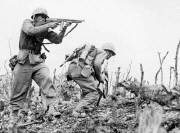
As the world mourned Roosevelt's death, an
inexperienced Truman began to grapple with his new job as president and commander in chief of the
armed forces . By then the war in Europe was winding down. In the Pacific, however, a ferocious
battle would soon rage on Okinawa, Japan's last defensive outpost. The Japanese unleashed more
than 1,900 kamikaze attacks on the Allies during the Okinawa campaign, sinking 30 ships, damaging
more than 300 more, and killing almost 5,000 seamen.
Once ashore, the Allies faced even
fiercer opposition than on Iwo Jima. By the time the fighting ended on June 22, 1945, more than 7,600
Americans had died. But the Japanese paid a still ghastlier price-110,000 lives-in defending Okinawa.
This total includes two generals who chose ritual suicide over the shame of surrender.
The
Battle for Okinawa was a chilling foretaste of what the Allies imagined the final invasion of
Japan's home islands would be like. Although some historians now think the projected toll was
vastly overestimated, Winston Churchill predicted that the cost would be a million American lives,
and half that number of British
|
|
|
69.
|
Who became president when FDR
died in 1045?
a. | Douglas
MacArthur | c. | Jimmy
Carter | b. | Harry Truman | d. | Lyndon Johnson |
|
|
|
70.
|
Which statement is
true?
a. | Okinawa enabled the U.S. to take the
Philippines back from Japan | c. | Okinawa was the last island the U.S. had to take before invading Japan
itself | b. | The battle of Okinawa was a defeat for both the U.S. and
Japan | d. | Okinawa was too far away from Japan to act as a base for
bomber attacks on Japan |
|
|
|
THE MANHATTAN PROJECT
Not long after Truman took
office, Secretary of War Henry Stimson handed him a memo that began, "Within four months we
shall in all probability have completed the most terrible weapon ever known in human history, one
bomb of which could destroy a whole city."
Over the next hour, the president learned that the Manhattan Project was
not only the most ambitious scientific enterprise in history but also the best-kept secret of the
war. At its peak, more than 600,000 Americans were involved in the project, although few of them knew
its ultimate purpose-the creation of an atomic bomb
Work on the atomic bomb had begun in 1942,
Meanwhile, a group of brilliant American, British, and European refugee scientists headed by J.
Robert Oppenheimer worked in a secret laboratory in Los Alamos, New Mexico, to build the actual
bomb.
As the time to test the bomb drew near, the air around Los Alamos crackled
with rumors and fears. Some feared that the bomb might not work. Others feared that the bomb might
set the atmosphere on fire. On the night of July 16, 1945, the first atomic bomb was detonated in an empty expanse of desert
near Alamogordo, New Mexico. A blinding flash, which was visible 180 miles away, was followed by
a deafening roar as a tremendous shock wave rolled across the trembling desert. A huge mushroom
cloud rose over the desert The bomb not only worked, but it was more powerful than most had dared
hope
|
|
|
71.
|
Which statement is true about
the Manhattan project..
a. | It was a plan to protect Manhattan
from attacks by German submarines | c. | It was plan to rescue refugees from the Germans in
Europe | b. | It was a secret plan to build an atomic bomb | d. | It was known but ignored by most
Americans |
|
|
|
72.
|
Which statement is true about
the Manhattan Project?
a. | The plan was so secret that Vice
President Truman did not know anything about it until he became
president | c. | Most government
officials knew about the plan but the general public did not | b. | The plan was well known by most people in the
government | d. | Truman never went to college and
really had trouble with complicated scientific ideas like atomic
physics |
|
|
|
TO BOMB OR NOT TO
BOMB
In spite of this
success, many of the scientists who had worked on the bomb, as well as many military leaders and
civilian policymakers, had doubts about using it. A petition drawn up by Leo Szilard, a leading
physicist in the Manhattan Project, and signed by 70 other scientists argued that it would be immoral to drop an atomic bomb on Japan
without fair warning. Others supported staging a demonstration of the bomb for Japanese leaders,
perhaps by exploding one on it deserted island near Japan, to convince their to surrender.
These objections were discussed in detail on May 31, 1945, by a newly formed advisory body,
the Interim Committee. At that meeting, Oppenheimer outlined the problems with a test
explosion: (1) nothing less than dropping a bomb on a city would convince the Japanese to surrender;
(2) the test might be a dud; (3) the Japanese might shoot down the delivery plane or move American
prisoners of' war into the test area. Swayed by these arguments, the committee recommended that
the bomb be used against military targets in Japan, and that it be dropped without
warning.
Many scientists working on the bomb agreed with this recomrnendation- even more so as
the heavy casualty figures from Iwo Jima and Okinawa sank in. "Are we to go on shedding American
blood when we have available means to a steady victory?" they asked in a petition. "No! If
we can save even a handful of American lives, then let its use this weapon-now!" But other
scientists retrained firmly opposed
Saving American lives, however, was not the only
consideration. Two other concerns pushed Americans to use the bomb. One was that the weapon
needed to be used to justify the cost of building it. Some people feared that if the bomb were not
dropped, the project might be viewed as a gigantic waste of money. The second consideration involved
the Soviet Union. Tension and distrust were already developing between the Western Allies and the
Soviets. Some American officials believed that a successful use of the atomic bomb would give the
United States a powerful advantage over the Soviets in shaping the postwar world.
Truman
did not hesitate . On July 25, 1945, he ordered the military to make final plans for dropping the
only two atomic bombs then in existence on Japanese targets . A day later, the United States
warned Japan that it faced "prompt and utter destruction" unless it surrendered at once.
Japan refused. Truman later wrote, "The final decision of' where and when to use the atomic
bomb was up to me. Let there be no mistake about it. I regarded the bomb as a military weapon and
never had any doubt that it should be used."
|
|
|
73.
|
The U.S. formed a committee to
discuss whether or not to drop the bomb. What was the issue they discussed
a. | would the bomb
work | d. | the blast had to be impressive
enough to convince the Japanese to surrender | b. | the delivery plane might
crash | e. | all of these were
discussed | c. | the Japanese might move American prisoners of war into the bomb
area |
|
|
|
74.
|
Which statement is
true
a. | The U.S. saw the Soviet Union as a
potential threat and wanted to use the atomic bomb to warn them | d. | none of these statements are
true | b. | The U.S. was not concerned about the cost of creating the bomb because
Americans at the time were so patriotic | e. | all of these statements are true | c. | Truman was against using the bomb but was convinced to use
it by his Secretary of War |
|
|
|
75.
|
President Truman showed a
disregard for the lives of Japanese civilians in deciding to drop the atomic bomb on Japanese
cities
|
|
|
76.
|
Which statement is
true.
a. | The scientific community was more
concerned with possible civilian casualties than American military
casualties | c. | Most government
and military leaders did not want Japan to surrender. They wanted Japan
destroyed. | b. | The battles of Iwo Jima and Okinawa made many people fear an
invasion of Japan so they decided to drop the atomic bomb to save American
lives | d. | None of these statements are
true |
|
|
|
HIROSHIMA AND
NAGASAKI
On August 6, a B-29 bomber named Enola Gay released an atomic bomb, code-named Little
Boy, over Hiroshima, an important Japanese military center. Forty-three seconds later, almost every
building in the city collapsed into dust. Hiroshima had ceased to exist. Still japans leaders
hesitated to surrender. Three days later a second bomb, code-named Fat Man, was dropped on Nagasaki,
leveling half the city. By the end of the year, an estimated 200,000 people had died as a result of
injuries and radiation poisoning caused by the atomic blasts .
Emperor Hirohito was horrified
by the death and destruction wrought by the bomb. "I cannot bear to see my innocent people
suffer any longer," he told Japan's leaders tearfully. Then he ordered them to draw up
papers "to end the war." On September 2, formal surrender ceremonies took place on the U.S.
battleship Missouri in Tokyo Bay. "Today the guns are silent," said General MacArthur in a
speech marking this historic moment. "The skies no longer rain death-the seas bear only
commerce-men everywhere walk upright in the sunlight . The entire world is quietly at
peace."
|
|
|
77.
|
What finally convinced
Emperor Hirohito to surrender
a. | The atomic bombs dropped on Japanese
cities | c. | The fear of the Russians who wanted
to take control of parts of Northern Japan | b. | The possible American
invasion | d. | His hatred and distrust of the
military leaders like Tojo |
|
|
|
78.
|
When did Japan officially
surrender to the Allied forces
a. | August 6,
1945 | c. | September 2,
1945 | b. | September 8, 1942 | d. | September 2, 1942 |
|
|
|
PREPARATION FOR
PEACE
In February 1945, Roosevelt had met with Churchill and Stalin at the
Soviet city of Yalta on the Black Sea. At the Yalta Conference, the three leaders made a number
of important decisions about the future. They agreed to move ahead in creating a new international
peacekeeping body, the United Nations (UN), based on the principles in the Atlantic Charter.
In exchange for Japan's Kuril and Sakhalin islands, Stalin promised to enter the war against
Japan after the surrender of Germany. He also promised "free and unfettered elections" in
Poland and in other Soviet-occupied Eastern European countries.
Yalta
What to do after the War is Over
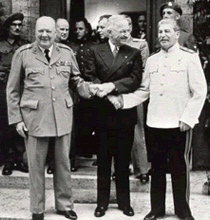
Churchill, Truman &
Stalin at the Yalta Conference |
The following April, representatives of 50 nations met
in San Francisco to establish the United Nations. By June they had agreed on a charter. The charter
created the General Assembly,
which was made up of all member nations and was expected to function as a "town meeting of the
world." The charter also set up administrative, judicial, and economic governing bodies
An 11-member Security Council held the real power, though. The five main wartime
Allies-the United States, Great Britain, the Soviet Union, France, and China-were given permanent
seats on the Security Council. At the insistence of the Soviet Union and the United States, each
permanent member had the power to veto any council action . The other six seats rotated to countries
elected by the General Assembly. As the charter was signed, hopes were high that the Security Council
would be far more effective than the League of Nations at keeping world peace
| | |
In July 1945,
President Truman met with Churchill and Stalin at Potsdam in defeated Germany. In addition to drawing
up a blueprint for disarming
Germany and eliminating the Nazi regime, the Allies agreed that "stern justice shall be
meted out to all war criminals, including those who have visited cruelties on our prisoners .
,
|
|
|
79.
|
While the U.S. and England were
fighting Japan, the Soviet Union refused to help.Why did the Soviet Union finally agree to declare
war on Japan in 1945?.
a. | The Soviets were afraid the U.S.
would invade them | c. | The Soviets were
afraid that the U.S. would drop atomic bombs on them | b. | The U.S. and England agreed to let the Soviets occupy the
Kuril and Sakhalin islands in Japan | d. | The U.S. and England agreed to allow the Soviet Union to take over Eastern
Europe and China |
|
|
|
80.
|
What two things did the U.S.,
England and the Soviet Union decide at Yalta in 1945?
a. | the United Nations and rebuilding
Europe | c. | the United Nations and a plan for
the Soviets to declare War on Japan | b. | the takeover of China by the Communists | d. | all of these statements are true |
|
|
|
81.
|
The first United Nations met at
San Francisco. How did the charter organize the U.N.?
a. | House of Representatives and
Security Council | c. | House an
Senate | b. | Senate and General Assembly | d. | General Assembly and Security
Council |
|
|
|
82.
|
The U.S., Great Britain and the
Soviet Union met at Potsdam in July, 1945. What post war problem did they work
on?
a. | how to disarm and punish the
Nazi’s | c. | how to rebuild
Europe | b. | how to organize the United Nations | d. | how to get the Soviet Union to declare war on Japan and help the
allies |
|
|
|
THE NUREMBERG WAR
TRIALS
In accordance with
decisions made at Potsdam, Germany
was divided into four zones, or sectors . The United States, Great Britain, France, and the
Soviet Union each occupied and administered one zone. Germany's capital, Berlin, although within
the Soviet zone, was also divided into four sectors, each administered by one of the occupying powers
.
During the next year, in an unprecedented move, an international tribunal representing 23
nations tried Nazi war criminals in Nuremberg, Germany. Twenty-two Nazi leaders were tried at
the first of the Nuremberg trials . They included Hitler's most trusted party officials,
government ministers, military leaders, and powerful industrialists. As the trial began, U .S.
Supreme Court justice Robert Jackson explained the significance of the event.
Twelve of the 22
defendants were sentenced to death, and most of the rest to prison. In later trials of lesser
leaders, nearly 200 more Nazis were found guilty of war crimes. For the first time in history a
nation's leaders had been held legally responsible for their actions during
wartime
|
|
|
83.
|
What happened at Nuremberg
after World War Two?
a. | plans were made to re-arm
Germany | c. | the Japanese and
German leaders were put on trial for war crimes | b. | the former Nazi leaders were put on trial for war
crimes | d. | plans were made to disarm
Germany |
|
|
|
84.
|
At the Potsdam conference the
Allies decided to divide Germany into _____ sectors.
a. | five | c. | German, American, British and
Soviet | b. | Allied and Axis | d. | American, French, British and
Soviet |
|
|
|
85.
|
The German capital of Berlin
was located inside the _____ sector
a. | Axis | c. | American | b. | Allied | d. | Soviet |
|
|
|
THE OCCUPATION OF JAPAN
Japan was occupied by U.S.
forces under the command of General
Douglas MacArthur. In the early months of the occupation, more than 1,100 Japanese, from former
prime minister Hideki Tojo to lowly prison guards, were arrested and put on trial. Seven, including
Tojo, were sentenced to death. In the Philippines, in China, and in other Asian battlegrounds,
additional Japanese officials were tried for atrocities against civilians or prisoners of
war.
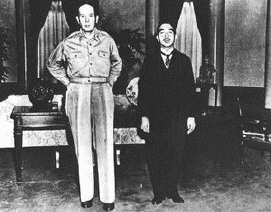
General MacArthur and Emporer
Hirohito | 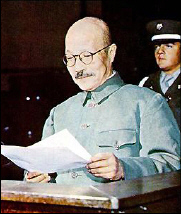
Tojo on trial for war
crimes | | |
During the
six-year American occupation, MacArthur reformed Japan's economy by introducing free-market practices
that led to a remarkable economic recovery. MacArthur also worked to transform Japan's
government. He called for a new constitution that would provide for woman suffrage and guarantee
basic freedoms . General MacArthur installed a democratic government presided over by a
very human emperor and based on the will of the people as expressed in free elections .To this
day, their constitution is known as the MacArthur Constitution.
Having taken care of
responsibilities to its allies and its enemies, America was ready to begin rebuilding at
home.
|
|
|
86.
|
Who was in charge of the
American occupation forces in Japan after WWII who helped Japan to make the transition to a
democratic nation
a. | General Dwight
Eisenhower | c. | Douglas
MacArthur | b. | prime minister Hideki Tojo | d. | Harry Truman |
|
|
|
87.
|
What was the MacArthur Constitution?
a. | MacArthur’s plan for punishing
former Japanese war criminals | c. | Japan’s constitution that MacArthur helped the Japanese to
write. | b. | A plan made by MacArthur to protect South Korea from the Communist
North | d. | MacArthur’s plan to rearm Japan for a possible war
with Communist China |
|
|
|
Opportunity and
Adjustment
World War II was a time of opportunity for millions of Americans. Jobs
abounded, and despite rationing and shortages, there was money to spend again. The war was
America's shining moment, and the nation emerged as the world's dominant economic and
military power.
ECONOMIC GAINS
The war years were good ones for working
people . As defense industries boomed, unemployment fell to a low of 1 .2 percent in 1944. Even
with price and wage controls, average weekly paychecks rose 70 percent during the war. And although
workers complained about long hours, overtime, and night shifts, they were also able to save money
for the future . Some workers invested up to half their paychecks in war bonds.
Farmers
also prospered during the war. Unlike the depression years, when farmers had battled dust storms
and floods, the early 1940s had good weather for growing crops. Farmers also benefited from
improvements in farm machinery and fertilizers and reaped the profits from rising crop prices . As a
result, crop production increased by 50 percent, and farm income tripled. Before the war ended, many
farmers could pay off their mortgages.
Women also enjoyed employment gains during the war,
although many lost their jobs when the war ended. Over 6 million women entered the work force for the
first time, boosting the percentage of women the total work force to 35 per cent. A third of those
jobs were in defense plants, which offered women more challenging work and better pay than such
traditional female jobs as waitressing, clerking, and domestic service. With men away at war, many
women also took advantage of openings in journalism and other professions.
Because of
shortages during the war, people did not have much to buy. There was a shortage of houses and no
automobiles or other consumer goods were produced during the war. People just saved their money. When
American industry finally started to produce consumer goods again, people had lots of money to buy
things. This pent-up demand helped the economy to grow dramatically in the years following
World War Two.
|
|
|
88.
|
Which group made economic gains
during World War Two?
a. | Farmers | c. | Workers | b. | Women | d. | All of these groups |
|
|
|
89.
|
Which statement is true and
work during World War Two?
a. | Women moved into the workforce in
defense factories and the professions | c. | Very few women became defense workers. Most remained at
home. | b. | Woman got jobs in the defense industry but failed to get jobs in other areas
of the economy | d. | Women got jobs in the professions
but did not make enough money to encourage them to work in defense
plants |
|
|
|
90.
|
What is it called when people
have a-lot of money and nothing to spend it on?
a. | supply-side
economics | c. | pent-up
supply | b. | savings cycle | d. | pent-up demand |
|
|
|
Population
Shifts
In addition to revamping the economy, the war
triggered one of the greatest mass migrations of American history. Not only were millions of
servicemen and women sent to places all over the world, but civilians were on the move as well.
Americans whose families had lived for decades in one place suddenly uprooted themselves to
seek war work elsewhere .
States with military bases and defense industries, such as Connecticut, Delaware, Maryland,
Michigan, Florida, and the Pacific Coast states, all experienced large population gains. More
than a million newcomers poured into California between 1941 and 1944. Towns with defense industries
saw their populations double and even triple, sometimes almost overnight.
Burbank,
California, the home of a major aircraft company, grew from 12,000 to 60,000 people in the first two
years of the war. The populations of some major cities-including Washington, D.C., Los Angeles, San
Francisco, Portland, Seattle, San Antonio, and Dallas jumped by a third or more.
The
inevitable result of such population booms was an acute housing shortage. Even though workers had money for rent, many were
virtually homeless . They camped out in tents, old cars, trailer parks, rented garages, and over
crowded rooming houses . Food was a problem as well. Many workers had no place to cook, yet because
of food rationing, there were not enough restaurants to feed them.
|
|
|
91.
|
What was the main reason for
the population shifts during World War Two?
a. | African Americans moved from the
South to escape persecution | c. | White people moved from the cities to escape urban violence and
gangs | b. | Workers moved to areas of the country that had defense
industries | d. | People moved from the cities to the
suburbs for better schools |
|
|
|
92.
|
Which statement is true about
population shifts during World War II?
a. | the civilian population that moved
experienced shortages | c. | there were housing
and transportation shortages but plenty of food | b. | there were food, housing and transportation shortages for
all Americans | d. | only the populations in non defense
areas experienced shortages |
|
|
|
SOCIAL
ADJUSTMENTS
Families adjusted to the changes brought on by war as
best they could. With millions of fathers in the armed forces, mothers struggled to rear their children alone .
Young children got used to being left with to work. Teenagers left at home without parents
sometimes drifted into juvenile delinquency. And when fathers finally did come home, there was
often a painful period of readjustment as families got to know one another
again.
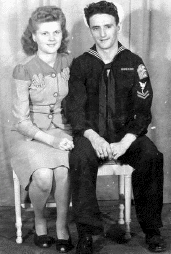 |
The war helped create new families, too, as it
triggered a huge marriage boom. Longtime sweethearts-as well as couples who barely knew each
other-rushed to marry before
the soldier or sailor was shipped overseas.
Many of these romances did not survive the long
separation, though. For numerous servicemen, the bad news came in much-dreaded "Dear
John" letters- letters from their wife or sweetheart, saying that she had found someone new.
In 1945, there were 502,000 divorces in the United States, or 31 for every 100 marriages .
This was double the prewar total and enough to give the United States the highest divorce rate in the
world.
| | |
In 1944, to help ease
the transition of returning servicemen to civilian life, Congress passed the Servicemen's
Readjustment Act, better known as the GI Bill of Rights. This bill provided education and training for veterans, paid
for by the federal government. Just over half the returning soldiers, or about 7.8 million veterans,
attended colleges and technical schools under the GI Bill. The act also provided federal loan
guarantees to veterans buying homes or farms or starting businesses. Because of this act,
millions who would otherwise never have been able to afford a college education or a house
went to school, became homeowners, and improved their economic prospects after the
war.
|
|
|
93.
|
Which statement is
true.
a. | Because of stronger family bonds
during the war, teens felt more secure | c. | World War II did not produce many cultural changes to American
families | b. | Because of changes in family life during the war, teens gained more
independence | d. | Because of World War II girls turned
away from marriage and sought careers |
|
|
|
94.
|
What was the purpose of the GI
Bill of Rights?
a. | Make sure that the civil rights of
the returning servicemen are not violated | c. | See that returning soldiers are not prosecuted for war
crimes | b. | Make sure that returning African American servicemen get civil
liberties | d. | Provide service to help servicemen
adjust to civilian life. |
|
|
|
95.
|
What were “Dear
John” letters?
a. | Letters sent to GI’s by their
wives and girlfriends telling them they found someone new | c. | Letters sent to President John Kennedy during the
war | b. | Letters sent by wives and girlfriends complaining about toilet facilities on
military bases | d. | Letters sent that accepted or
proposed marriage. |
|
|
|
AFRICAN AMERICANS IN THE
MILITARY
For African Americans, World War II was a turning
point of sorts. On the one hand, segregation remained the rule in the military. Not only were African
Americans assigned to all-black units, but many of them were assigned to rigidly segregated camps in
the South for their training .
On the other hand,
under great pressure from civil rights organizations, the military no longer restricted its all-black
units to menial tasks. Many black
units distinguished themselves in combat, including the famous 92nd Infantry Division, nicknamed the
Buffaloes. In just six months of fighting in Europe, the Buffaloes won 7 Legion of Merit awards,
65 Silver Stars, and 162 Bronze Stars for courage under fire. The 99th Fighter Squadron, better known
as the Tuskegee Airmen, won two Distinguished Unit Citations (the military's highest
commendation) for its outstanding aerial combat against the German Luftwaffe.
AFRICAN
AMERICANS AT HOME
African Americans also made some progress on the home front. During the
war, about 330,000 blacks left the South . The majority moved to the West Coast. There they found not
only jobs, but good jobs . In 1942, civil rights leader James Farmer founded an interracial
organization called the Congress of Racial Equality (CORE) to confront urban segregation in
the North. That same year, CORE staged its first sit-in at a segregated Chicago restaurant
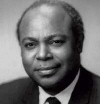
James Farmer
|
|
|
96.
|
Which statement is
true?
a. | African Americans in the military
were not assigned to combat duties until 1946 | c. | African Americans were assigned to ground combat but prohibited from flying
airplanes | b. | At first African Americans were assigned to non-combat duties until civil
rights organizations pressured for change | d. | There were no restrictions on African Americans in the
service |
|
|
|
97.
|
James Farmer started CORE to
integrate African Americans in Northern cities
|
|
|
JAPANESE AMERICANS IN THE
WAR EFFORT
For Japanese Americans locked up in U.S. internment camps, the war was a
daily struggle to maintain their dignity in the face of injustice. Many young men escaped the camps
by volunteering for military service.
At the urging of General Delos Emmons, the army created
the 100th Battalion, which consisted of 1,400 Hawaiian Nisei. The 100th fought in North Africa and
Italy, where it saw brutal combat, becoming known as the Purple Heart Battalion because 300
of its soldiers were killed and another 650 were Wounded
Later the 100th was merged into
the all-Nisei 442nd Regimental Combat Team, whose slogan was "Go for Broke." It became
the most decorated combat unit of the war. The 442nd took heavy casualties-more than one
fourth of the unit-in the Italian campaign and then was ordered to France, where the Nisei captured
the town of Bruyeres in house-to-house fighting. After that they were sent to rescue the "Lost
Battalion--a unit of 211 Americans surrounded by the Germans in the Vosges Mountains.
Japanese Americans also fought for justice, both in the courts and in Congress . The initial
results were discouraging . In 1944, the Supreme Court decided, in Korematsu v. United States,
that the government's policy of evacuating Japanese Americans to camps was justified on the
basis of "military necessity." After the war, however, the Japanese American Citizens
League (JACL) pushed the government to compensate those sent to the camps for their lost property. In
1965, Congress authorized the spending of $38 million for that purposeless than a tenth of Japanese
Americans' actual losses . In 1942 the Federal Reserve Bank in San Francisco estimated that the
relocation had cost evacuees $400,000,000
|
|
|
98.
|
What was the Purple Heart
Battalion?
a. | an army unit made up of 1,400 Hawaii
Islanders | c. | an army unit made
up of 1,400 Japanese from the Los Angeles area | b. | an army unit made up of 1,400 Hawaii
Japanese | d. | an army unit made up of anyone in
the service who received a purple heart. |
|
|
|
99.
|
Where did the Japanese American
soldiers do most of there service?
a. | In battles over Japanese held
islands | c. | In the war in
Europe with frontline combat units | b. | In U.S. non-combat units | d. | In the war in Europe in service units such as truck drivers, cooks and supply
clerks |
|
|
|
100.
|
Who rescued the Lost Battalion
that was surrounded by Germans.
a. | George Patton’s third
army | c. | the all-Nisei 442nd Combat
Team, | b. | The Korematsu all Japanese combat unit | d. | a mixed Japanese, and German American 442nd Combat
Team |
|
|
|
101.
|
How did the Supreme Court rule
in the Korematsu v. United States case?
a. | Japanese Americans should receive
compensation for their illegal imprisonment during World War II | c. | the Japanese American Citizens
League (JACL) had no right to push the government to compensate Japanese
Americans | b. | The government had no right to put Japanese Americans in camps for the
duration of the war | d. | The government had a right to put
Japanese Americans in camps for the duration of the war |
|
|
|
102.
|
This is what the atomic bomb
program came to be called.
a. | Atomic Bomb Project
ABP | c. | Office of Scientific
Research | b. | Office of Energy Production | d. | Manhattan Projece |
|
|
|
103.
|
This was created by Congress to
fight the threat of inflation.
a. | Wartime Inflation
Board | c. | Office of Price
Administration | b. | Manhattan Project | d. | Works Progress Administration |
|
|
|
104.
|
This instituted the draft and
eventually mustered ten million soldiers
a. | CCC Civilian Conservation
Corp | c. | Social Security
System | b. | Selective Service System | d. | American Legion |
|
|
|
105.
|
This was the method used to
decrease the use of scarce and essential wartime goods.
a. | Social Security
System | c. | rationing | b. | Welfare | d. | Costco |
|
|
|
106.
|
This term refers to Japanese
Americans who were born in the United States
a. | Nisei | c. | American Bund | b. | Nippon | d. | Native Americans |
|
|
|
107.
|
This Army chief of Staff pushed
for the formation of a Women's Axiliary Army Corps.
a. | Douglas
McArthur | c. | George
Marshall | b. | George Patton | d. | Alger Hiss |
|
|
|
108.
|
This labor leader strongly
encouraged President Roosevelt to issue an executive order discouraging discrimination in
workplace.
a. | A. Phillip
Randolf | c. | James
Hoffa | b. | George Meany | d. | Martin Luther King |
|
|
|
109.
|
This assumed the responsibility
for converting industry from peace-time to wartime production and distributing raw materials to key
industries.
a. | American Federation of
Labor | c. | National Association of
Manufacturers | b. | Industry Conversion Board | d. | War Production Board WPB |
|
|
|
110.
|
This was responsible for
improvements to radar and sonar and the development of "wonder drugs" such as penicillin
that saved countless lives.
a. | National Science
Foundation | c. | Office of
Scientific Research and Development | b. | United Way | d. | National Broadcasting System |
|
|
|
111.
|
He was Franklin Roosevelts Vice
President.
a. | Spiro
Agnew | c. | Harry
Truman | b. | George Marshall | d. | Dwight Eisenhower |
|
|
|
112.
|
This day marked the end of
World War II in Europe
a. | Armistice
Day | c. | V-J
Day | b. | V-E Day | d. | D-Day |
|
|
|
113.
|
This death camp was the first
to be liberated by the Allies in WWII
a. | Majdanek | c. | Stalingrad | b. | Awschwicz | d. | Donovan |
|
|
|
114.
|
This general commanded the
invasion of North Africa in WWII
a. | George
Patton | c. | Dwight
Eisenhower | b. | George Marshall | d. | McArthur |
|
|
|
115.
|
This day marked the invasion of
Nazi-controlled France
a. | D-Day | c. | V-J Day | b. | V-E Day | d. | September 30, 1939 |
|
|
|
116.
|
This involved the invasion of
Axis-controlled North Africa
a. | Battle of the
Bulge | c. | Majdanek | b. | Battle of Stalingrad | d. | Operation Torch |
|
|
|
117.
|
Convoys, sonar and radar helped
the Allies to win this battle.
a. | Battle of the
Atlantic | c. | Battle of
Britain | b. | Battle of the Bulge | d. | Battle of Midway |
|
|
|
118.
|
This general let the American
troops that liberated Paris from German occupation.
a. | Dwight
Eisenhower | c. | General
Rommel | b. | George Marshall | d. | George Patton |
|
|
|
119.
|
The initial success of this
German offensive battle was due mainly to the Allies being caught off guard.
a. | Battle of the
Bulge | c. | Normandy
Invasion | b. | Battle for France | d. | Pearl Harbor |
|
|
|
120.
|
Which of the following economic
problems was targeted by the office of Price Administration?
a. | inflation | c. | depression | b. | recession | d. | unemployment |
|
|
|
121.
|
The term Nisei refers to
Japanese Americans who ...
a. | were born in the
U.S. | c. | volunteered to fight in the U.S.
armed forces | b. | were forced into internment camps | d. | volunteered to serve as spiesin the war against
Japan |
|
|
|
122.
|
Who was the Supreme Commander
of U.S. forces in Europe in WWII?
a. | George
Patton | c. | Douglas
MacArthur | b. | George Marshall | d. | Dwight Eisenhower |
|
|
|
123.
|
In the Battle of Stalingrad,
all of the following contributed to the Soviet victory except
a. | a brutal
winter | c. | a massive Soviet
counterattack | b. | a massive Allied invasion | d. | Hitler's refusal to order a German
retreat |
|
|
|
124.
|
D-Day was the code name for the
Allied invasion of ...
a. | Italy | c. | France | b. | Japan | d. | North Africa |
|
|
|
125.
|
The purpose of the Manhattan
Project was to
a. | build the atomic
bomb | c. | decide whether to drop the atomic
bomb | b. | decide where to drop the atomic bomb | d. | design a variety of new weapons, including the atomic
bomb |
|
|
|
FRED KOREMATSU v. UNITED
STATES
Throughout the
1930's the Nisei (first
generation native-born Japanese) dreaded the possibility of a war between the United States and Japan
as relations between the two countries deteriorated steadily. Japan made a brutal attack on China in
the early 1930’s which the U.S. objected to. Japan, at war with China since 1937, continued to
gain territory there. In 1941, the Japanese moved into Indochina (now Vietnam) and threatened the
Dutch East Indies. The United States stopped almost all trade with Japan.
By mid 1941 the Japanese
ambassador to the United States, Kichisaburo Nomura, and Secretary of State Cordell Hull had been
negotiating for months. In November Nomura was joined in Washington, D.C. by a special Japanese
ambassador, but the talks were still unsuccessful. The United States pressured Japan to withdraw from
China in return for resumption of trade, but Japan would not agree. Discussions continued as the
Japanese planned to attack Hawaii.
|
|
|
126.
|
What was the cause of bad
relations between Japan and the U.S.?
a. | Japan attacked
China | c. | Japan was attacking other nations in
Asia | b. | Japan was attempting to expand its empire into Southeast
Asia | d. | All of these are reasons for poor relations between the
U.S. and Japan |
|
|
|
127.
|
How did the U.S. respond to
Japanese aggression in Asia?
a. | The U.S. threatened to attack
Japan | c. | The U.S. established a trade embargo
against Japan | b. | The U.S. sent new ships to the Chinese navy | d. | The U.S. did nothing |
|
|
|
128.
|
What was Japan doing during the
negotiations with Secretary of State, Cordell Hull?
a. | planning to remove their troops from
China | c. | searching for ways to imporve
relations with the U.S. | b. | planning an attack on Pearl Harbor | d. | planning an attack on German interests in
Africa |
|
|
|
The Japanese bombed Pearl
Harbor, Hawaii, on December 7, 1941, and after Japanese conquests in the Pacific, near hysteria
gripped the West Coast of the United States. Many people feared that Japan would attack there. At the
time of the bombing there were approximately 112,000 persons of Japanese descent living on the West
Coast, about 70, 000 of whom were American citizens. The other 42,000 were enemy aliens. (An enemy
alien is a person who is the citizen of a country that the U.S. is at war with)
|
|
|
129.
|
How did America react to the
attack on Pearl Harbor
a. | Americans thought Japan might attack
the West Coast of the U.S. | c. | Americans took the news with a calm sense of
confidence | b. | America felt secure that the Pacific ocean would protect us against
attack | d. | America did not react.
|
|
|
|
130.
|
How many citizens of Japan were
living on the West coast when Japan attacked Pearl Harbor
a. | about
70,000 | c. | about
4,200 | b. | about 42,000 | d. | none |
|
|
|
In March 1942, Congress passed
legislation empowering President Franklin D. Roosevelt by executive order and cabinet or military
orders under his direction to restrict movement or residence in any designated military area or war
zone where he felt that such restriction was necessary to national security. Because of growing fear
that an invasion of the West Coast was imminent and lurking suspicions about the loyalty of Japanese
Americans living along the coast, President Roosevelt issued Executive Order #9066. This order
declared that "the successful prosecution of the war requires every possible protection against
espionage and against sabotage to national defense material, national defense premises, and national
defense utilities." The order came to be applied increasingly to people of Japanese ancestry,
citizen and alien alike. The restrictions ranged from the imposition of curfews to forced removal to
"relocation centers" outside Military Area I.
|
|
|
131.
|
Who gave President Roosevelt
the right to restrict the movement of aliens in the U.S.
a. | the
Army | c. | the
FBI | b. | the Supreme Court | d. | the Congress |
|
|
|
132.
|
Who issued Executive Order
9066?
a. | The FBI | c. | President Roosevelt | b. | The Congress | d. | none of these |
|
|
|
133.
|
What did Executive Order 9066
allow the president to do
a. | restrict the movements of people
suspected of espionage | c. | send the U.S.
military into action against Japan | b. | send U.S. citizens back to their former
countries | d. | send the U.S. military into action
against Germany and Japan |
|
|
|
At the time of the announcement
of the exclusion order, Fred
Korematsu was in his early twenties. He was of Japanese ancestry but was born in Oakland, California.
A graduate of Oakland High School, Korematsu had tried twice to enlist in the army but was turned
down for a physical disability. Before and after the bombing of Pearl Harbor, Fred worked in defense
plants in the San Francisco area. He had no criminal record and had been a loyal, law-abiding
American citizen. Had he obeyed the order, he would have been separated from his Caucasian girl
friend, so rather than submit to confinement he ran away. Posing as Chinese, Korematsu took a job in
a trailer park.
Arrested in May,
Korematsu was tried in a federal district court. He challenged the order as it applied to him, a
loyal citizen of the United States, but he was found guilty of knowingly violating the Civilian
Exclusion Order. Korematsu appealed the district court's decision to the U.S. Circuit Court, but
his conviction was sustained. He was confined in a relocation center in Utah while he appealed his
case to the United States Supreme Court.
|
|
|
134.
|
Fred Korematsu was a citizen of
a. | Japan | c. | Canada | b. | the U.S. | d. | Utah |
|
|
|
135.
|
How did Fred Korematsu avoind
the executive order?
a. | he pretended to be Chinese and
worked in a defense plant | c. | he tried to escape to Japan | b. | he ran away to Canada | d. | he tried to escape to China |
|
|
|
136.
|
Fred Korematsu was arrested and
tried in Federal Court for violating the Exclusion order. What was the outcome of the
case
a. | it was a
mistrial | c. | he was found
innocent | b. | it was a hung jury | d. | he was found guilty |
|
|
|
137.
|
Why did Fred Karematsu try to
avoid the exclusion order?
a. | Korematsu did not try to avoid the
Exclusion order | c. | He did not want to
serve in the Army | b. | He did not want to be seperated from his
girlfriend | d. | He did not like
Utab |
|
|
|
138.
|
What was the highest court that
Fred Korematsu appealed to
a. | the World Court in the
U.N | c. | the Supreme Court of the
U.S. | b. | the Supreme Court of California | d. | he did not appeal his conviction to any
court |
|
|
|
139.
|
What happened to Fred Korematsu
while he was appealing his conviction in court?
a. | he was let out on
bail | c. | he was confined to a relocation camp
in Utah | b. | he was allowed to stay with his family in San
Francisco | d. | he was allowed to marry his
girlfriend and live with her parents |
|
Matching
|
|
|
a. | War Production Board (WPB)
| n. | Manhattan Project
| b. | Harry S. Truman
| o. | George Marshall | c. | Hiroshima | p. | Congress of Racial Equality (CORE) | d. | Dwight D. Eisenhower | q. | Douglas MacArthur | e. | J. Robert Oppenheimer | r. | Nagasaki | f. | Chester Nimitz | s. | Office of Price Administration (OPA)
| g. | Philip Randolph
| t. | Yalta Conference | h. | Battle of the Bulge | u. | V-E Day | i. | D-Day | v. | United Nations (UN)
| j. | Nuremberg Trials
| w. | Nisei | k. | rationing | x. | kamikaze | l. | GI Bill of Rights | y. | Japanese American Citizens League (JACL) | m. | George Patton | z. | James Farmer |
|
|
|
140.
|
German counteroffensive in
December 1944
|
|
|
141.
|
Agency of the federal
government that fought inflation
|
|
|
142.
|
Commander of American naval
forces in the Pacific
|
|
|
143.
|
Victory in Europe Day,May 8,
1945
|
|
|
144.
|
Army chief of staff during
World War
|
|
|
145.
|
Allied invasion of Normandy to
liberate Europe
|
|
|
146.
|
Japanese suicide
plane
|
|
|
147.
|
Government agency that decided
which companies would make war materials and how to distribute raw
materials
|
|
|
148.
|
Japanese city that was the
site of the second atomic-bomb drop
|
|
|
149.
|
American commander in the
Philippines Military governor of Japan after World War Two
|
|
|
150.
|
American general Supreme
Allied Commander in Europe
|
|
|
151.
|
Secret project to develop the
atomic bomb
|
|
|
152.
|
Important African-American
labor leader
|
|
|
153.
|
33rd president of the United
States - took office after FDR died
|
|
|
154.
|
City that was the site of the
first atomic-bomb drop in Japan
|
|
|
155.
|
Scientist who led the
Manhattan Project
|
|
|
156.
|
Japanese Americans born in the
United States
|
|
|
157.
|
American general led American
forces that defeated Erwin Rommel in Africa
|
|
|
158.
|
Restricting the amount of food
and other goods people may buy during wartime to assure adequate supplies for the
military
|
|
|
159.
|
International organization
formed in 1945
|
|
|
160.
|
Tribunal that tried Nazi
leaders for war crimes
|
|
|
161.
|
Meeting of Truman, Churchill,
and Stalin in 1945
|
|
|
162.
|
Civil rights group formed by
Japanese Americans
|
|
|
163.
|
Law passed by Congress to help
servicemen readjust to civilian life
|
|
|
164.
|
Civil rights leader who
founded the Congress of Racial Equality
|
|
|
165.
|
Interracial organization
formed to fight discrimination
|
|
|
a. | nisi | f. | War Production Board WPB | b. | rationing | g. | Seletive Service System | c. | George Marshall | h. | Office of Price Administration OPA | d. | Manhattan Project | i. | Office of Scientific Research and
Development | e. | A. Phillip Randolph |
|
|
|
166.
|
This is what the atomic bomb
program came to be called
|
|
|
167.
|
This was created by Congress
to fight the threat of inflation
|
|
|
168.
|
This instituted the draft and
eventually mustered ten million soldiers.
|
|
|
169.
|
This was the method used to
decrease the use of scarce and essential
wartime goods.
|
|
|
170.
|
This term refers to Japanese
Americans who were born in the United
States.
|
|
|
171.
|
This Army Chief of Staff
pushed for the formation of a Women’s
Auxiliary Army Corps.
|
|
|
172.
|
This labor leader strongly
encouraged President Roosevelt to issue an
executive order discouraging discrimination in the
workplace.
|
|
|
173.
|
This assumed the
responsibility for converting industry from peacetime
to wartime production and distributing raw
materials to key
industries.
|
|
|
174.
|
This was responsible for
improvements in radar and sonar and the development
of “wonder drugs” such as
penicillin that saved countless lives.
|
|
|
a. | 1942 | i. | Nisei | b. | 42,000 | j. | Found guilty and relocated to Utah | c. | 14th Amendment to
Constitution | k. | 112,000 | d. | trade with the U.S. | l. | Moved Japanese to secure area where they could be watched by the
military | e. | Franklin Delano Roosevelt | m. | Appealed to the Supreme Court | f. | Fred Korematsu | n. | 1937 | g. | Fear we would be invaded by Japan | o. | Executive Order 9066 | h. | Cordell Hull | p. | Indochina (Viet Nam) |
|
|
|
175.
|
Japan invaded
China
|
|
|
176.
|
Law passed by Congress in
_____ giving president power to issue executive orders to restrict movement in any military
area
|
|
|
177.
|
Declared that “the
successful prosecution of the war requires every possible protection against espionage and against
sabotage to national defense material, national defense premises and national defense
utilities.”
|
|
|
178.
|
Japan was promised a
resumption of _____ if it withdrew its forces from China.
|
|
|
179.
|
First generation native-born
Japanese American citizens
|
|
|
180.
|
Number of Japanese living on
the West Coast when Japan attacked Pearl harbor.
|
|
|
181.
|
Number of Japanese living on
the West Coast, who were not citizens of the U.S., when Japan attacked Pearl
Harbor
|
|
|
182.
|
In 1941 Japan moved into _____
and threatened the Dutch East Indies
|
|
|
183.
|
He refused to be re-located
with other Japanese Americans because he wanted to be with his Caucasian girl
friend.
|
|
|
184.
|
Equal Protection of the
Law
|
|
|
185.
|
Action taken by Fred Korematsu
because he was found guilty of violating an executive order
|
|
|
186.
|
Action against Fred
Korematsu
|
|
|
187.
|
Results of Executive Order
9066
|
|
|
188.
|
Attitude of Americans after
attack on Pearl Harbor
|
|
|
189.
|
Signed Executive Order
9066
|
|
|
190.
|
U.S. Secretary of State in
1941
|